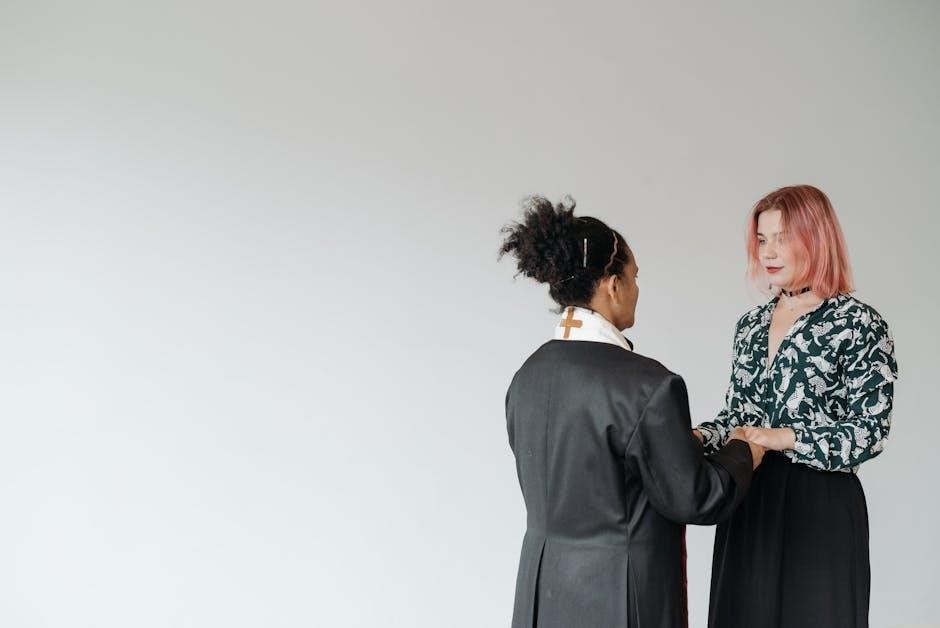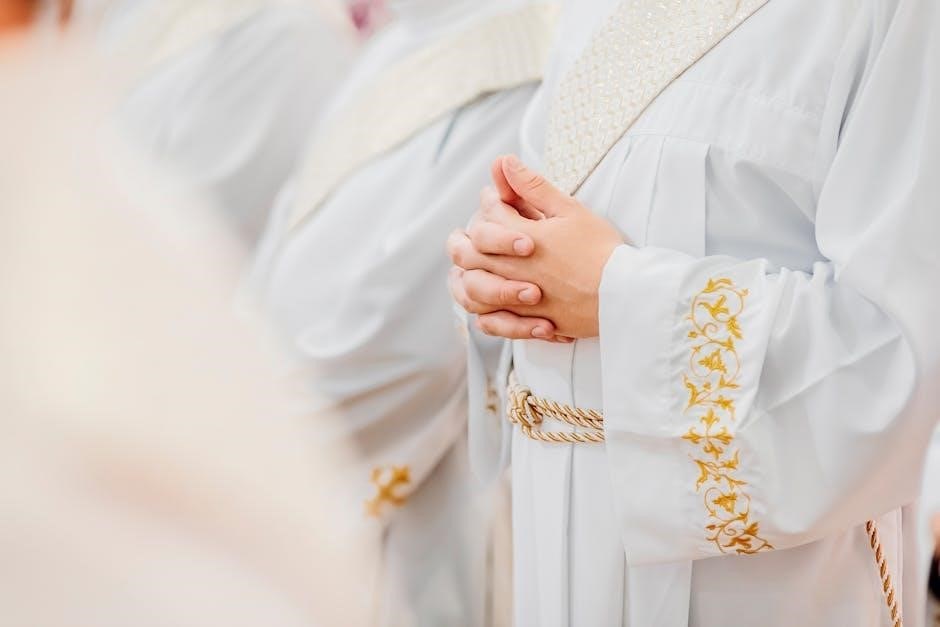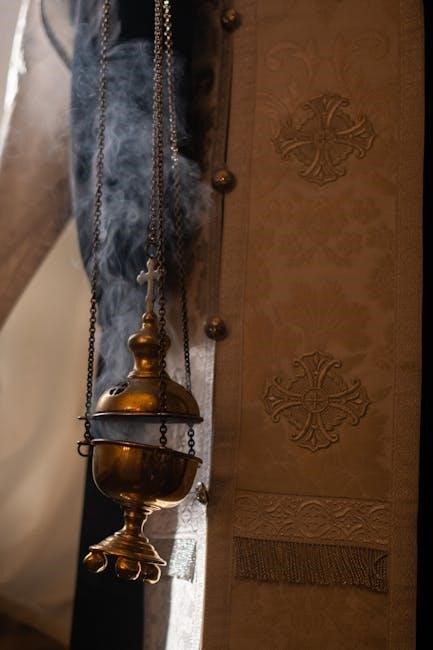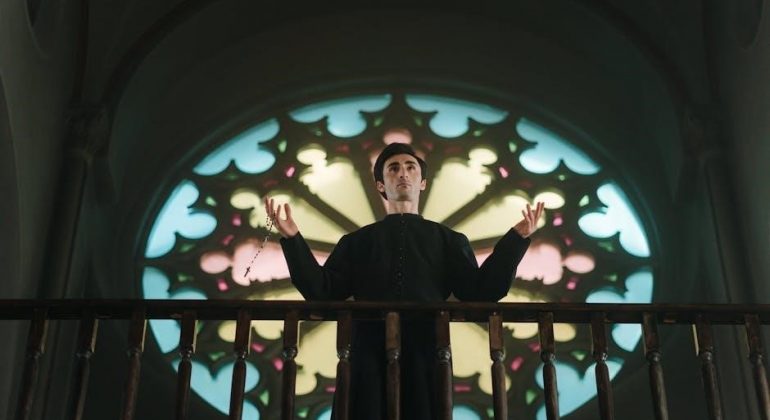The High Priest’s garments symbolize holiness, mediation, and service, crafted with meticulous detail to reflect divine standards; Made from gold, linen, and red wool, they embody purity, righteousness, and humanity’s spiritual aspirations. These sacred robes connect to Eden’s narrative and humanity’s ideal role, representing the New Adam.
Historical and Biblical Context
The High Priest’s garments are deeply rooted in biblical history, first described in Exodus 28, where God instructed Moses to craft them for Aaron, the first High Priest. These robes were central to the ritual practices of the Israelites, symbolizing the priest’s role as a mediator between God and humanity. The garments were worn during sacred ceremonies, including the annual Day of Atonement, where the High Priest would enter the Holy of Holies to atone for the sins of the people. The intricate design and materials used, such as gold, linen, and red wool, reflected the divine standards of holiness and purity. The Bible emphasizes that these garments were not only functional but also symbolic, representing the priest’s consecration to God’s service. The historical context highlights the garments’ significance in the Tabernacle and later in the Temple, serving as a visual reminder of God’s presence among His people. The detailed instructions for their creation underscore the importance of ritual purity and the sacred nature of worship in ancient Israelite culture.
Overview of Symbolism
The High Priest’s garments are rich in symbolic meaning, reflecting divine standards of holiness, purity, and mediation. Each element of the attire, from the breastplate to the turban, carries profound spiritual significance. The use of gold, linen, and red wool symbolizes purity, righteousness, and humanity’s dual nature, while the intricate designs and colors point to God’s grandeur and the priest’s role as a mediator. These garments also draw parallels to the Garden of Eden, representing humanity’s original purity and its restoration through divine grace. The High Priest’s robes embody the idea of the “New Adam,” symbolizing humanity’s redemption and its elevated spiritual calling. Furthermore, the garments serve as a visual reminder of the priest’s consecration to God’s service and the sacredness of worship. The symbolism woven into these robes underscores the priest’s responsibility to uphold moral and spiritual integrity, while also foreshadowing Christ’s ultimate role as the mediator between God and humanity. This rich tapestry of meanings highlights the garments’ profound spiritual and historical significance.
The Breastplate of Judgment
The Breastplate of Judgment, a central element of the High Priest’s attire, symbolizes divine communication and wisdom. Positioned over the High Priest’s heart, it contained 12 precious stones, each engraved with the names of Israel’s tribes, signifying the priest’s role in bearing the people before God. The breastplate housed the Urim and Thummim, tools used to seek God’s judgment and guidance. This sacred piece of jewelry embodied the High Priest’s responsibility to discern God’s will and mediate divine decisions. The Breastplate of Judgment also symbolized Christ, who, as the ultimate High Priest, perfectly interprets and fulfills God’s will. Its presence on the High Priest’s garments underscored the importance of seeking divine guidance in all matters. The breastplate’s intricate design and placement over the heart emphasized the connection between wisdom, judgment, and the sacred calling of the priest. This piece of the High Priest’s clothing remains a powerful symbol of God’s desire to communicate with humanity and the priestly role of intercession. Its significance extends to believers today, reminding them of the importance of seeking divine wisdom and guidance in their lives.
The Ephod and Its Significance
The Ephod, a key component of the High Priest’s garments, was a intricately woven vestment made from gold, blue, purple, and scarlet yarns, along with fine linen. Its significance lies in its role as a symbol of divine connection and priestly authority. The Ephod was worn over the High Priest’s shoulders and chest, with two onyx stones engraved with the names of the tribes of Israel. These stones represented the High Priest’s responsibility to carry the people of Israel before God in prayer and mediation. The Ephod’s design emphasized the priest’s role as a bridge between God and humanity, bearing the burden of the people’s needs and sins. The use of precious materials and vibrant colors underscored the Ephod’s sacred purpose, reflecting God’s glory and the High Priest’s divine calling. The Ephod also symbolized Christ, who, as the ultimate High Priest, bears the names of His people and intercedes on their behalf. This garment remains a profound symbol of spiritual leadership, divine communication, and the priestly ministry. Its legacy continues to inspire reverence and awe in modern worship and reflection.
The Robe of the Ephod
The Robe of the Ephod, attached to the Ephod, was a blue garment made entirely of fine woven linen, symbolizing heaven and God’s divine presence. It featured a hem adorned with golden bells alternating with pomegranates of blue, purple, and scarlet yarn. The bells signified the High Priest’s approach to God, announcing his entrance into the Most Holy Place, while the pomegranates, a fruit symbolizing abundance and righteousness, emphasized fertility and spiritual growth. The robe’s color, blue, represented the heavens and God’s throne, reinforcing the priest’s role as a mediator between heaven and earth. The absence of any tears or seams in the robe symbolized the High Priest’s wholeness and integrity before God. This garment was essential during rituals, ensuring the priest’s safety and efficacy in performing sacred duties. The robe’s design and symbolism underscored the High Priest’s divine calling and the sacred nature of his ministry, prefiguring Christ’s role as the ultimate High Priest who intercedes for humanity.
The Turban and Its Symbolism
The turban, a key component of the High Priest’s attire, symbolized consecration, dignity, and divine holiness. Made from fine linen, it was worn exclusively by the High Priest, distinguishing him from ordinary priests. The turban’s design featured a unique golden plate inscribed with “Holiness to the Lord,” signifying the priest’s sanctification and his role as a mediator between God and humanity. This plate was a constant reminder of the High Priest’s responsibility to uphold divine standards and intercede on behalf of the people.
The turban’s elevated position on the head symbolized the High Priest’s spiritual elevation and his connection to heaven. It also represented the burden of leadership, as the High Priest carried the weight of his people’s sins before God. The turban’s pure linen fabric underscored the importance of moral and spiritual purity, essential for one who ministered in the holy presence of God. Its design and symbolism prefigured Christ, who would later fulfill the role of the ultimate High Priest, interceding for humanity with perfect righteousness and holiness.
The turban’s presence in the High Priest’s garments emphasized the theological truths of sanctification, divine presence, and the necessity of a mediator between God and humanity. It remains a profound symbol of spiritual leadership and the pursuit of holiness in worship and service.

The Undergarments
The undergarments of the High Priest, made from fine linen, symbolized purity and righteousness. These garments were designed to cover the priest’s body modestly, ensuring humility and dignity. The undergarments were worn next to the skin, making them a foundational layer of the High Priest’s attire. Their simplicity and lack of embellishment contrasted with the more elaborate outer garments, emphasizing the importance of inner purity over external display.
The undergarments were part of the holy garments but were not visible to others, symbolizing the hidden aspects of holiness that are essential for those who serve God. They were made of fine linen, a material associated with purity and righteousness, reflecting the priest’s need for moral and spiritual cleanliness. The undergarments also represented the idea that true holiness begins internally and is the foundation for external service and worship.
The undergarments’ design and purpose connected to the broader narrative of humanity’s role in Eden and the restoration of that role through the New Adam. They reminded the High Priest of his sacred responsibility to maintain purity in his personal life, which was essential for his ministry. This symbolism extends to believers today, emphasizing the importance of inner purity and righteousness in serving God.

The Significance of Gold
Gold in the High Priest’s garments symbolizes divine purity, value, and the immutable nature of God. It was used in the breastplate, ephod, and turban, representing the priest’s role as a mediator between God and humanity. Gold’s incorruptible nature mirrored the enduring purity required for spiritual service.
The use of gold emphasized the sacredness of the priesthood and the glory of God. It also reflected the high value placed on the priest’s ministry, as gold was a precious and costly material. The intricate craftsmanship of gold in the garments highlighted the divine perfection and beauty associated with worship.
Gold’s presence in the High Priest’s attire connected to the Garden of Eden narrative, symbolizing humanity’s original purity and the restoration of that state through the New Adam. It represented the ideal of humanity living in harmony with God, embodying both spiritual and physical purity.
The Role of Linen
Linen in the High Priest’s garments symbolizes purity and righteousness, crafted from fine, white flax. It was used in the tunic, undergarments, and parts of the robe, signifying the priest’s moral integrity and spiritual cleanliness before God. Linen’s whiteness represented the purity of heart required for divine service.
The tunic of fine woven linen, worn next to the skin, embodied the idea of humility and modesty. It also symbolized the covering of Christ’s righteousness, as the priest’s humanity was clothed in divine perfection. Linen’s natural, unblemished state mirrored the untainted holiness expected of those serving in the sacred office.
The use of linen in the High Priest’s garments connected to the Garden of Eden narrative, where humanity was originally clothed in garments of light. This material represented the restoration of humanity’s ideal spiritual state, free from sin and corruption; Linen’s simplicity and elegance underscored the priest’s role as a mediator between God and humanity.
In essence, linen in the High Priest’s attire was a powerful symbol of purity, humility, and the divine righteousness that believers are called to emulate. It reflected the priest’s sacred duty to serve as a living representation of God’s holiness and humanity’s redeemed state.
The Symbolism of Red Wool
Red wool in the High Priest’s garments symbolizes the animal aspect of humanity, representing life, flesh, and blood. It signifies the earthly, physical nature of mankind, distinguishing it from the spiritual purity of linen and the divine nature of gold. The red wool was used in specific parts of the garments, such as the ephod and the girdle, to emphasize the priest’s role in atoning for sin.
The color red is deeply connected to sacrifice and atonement, as it represents the shedding of blood to cover sin. This aligns with the High Priest’s duty to offer sacrifices on behalf of the people. The red wool also symbolizes humanity’s frailty and the need for divine redemption, reflecting the dual nature of humanity as both physical and spiritual beings.
In contrast to the white linen, which represents purity and righteousness, red wool highlights the earthly and carnal aspects of human nature. Its inclusion in the High Priest’s attire underscores the necessity of addressing both the spiritual and physical dimensions of humanity in the process of atonement and reconciliation with God.
Connection to the Garden of Eden
The High Priest’s garments symbolically connect to the Garden of Eden, emphasizing humanity’s original state of purity and divine intimacy. Eden represents the pinnacle of human relationship with God, where Adam and Eve lived in harmony and innocence. The garments, with their intricate design and sacred materials, reflect this ideal state, reminding the priests of their role in restoring humanity’s spiritual connection to God.
The use of gold, linen, and red wool in the garments mirrors the harmony of Eden. Gold signifies divine purity, while linen represents human righteousness, and red wool symbolizes the earthly, physical nature of humanity. Together, these materials remind the High Priest of the balance between the divine and human realms, much like the Garden’s perfect state.
The priestly garments also evoke the memory of Eden through their color scheme and craftsmanship. The blue, purple, and scarlet dyes used in the fabrics symbolize the heavens, royalty, and the blood of life, respectively, reflecting the divine order and beauty of Eden. By wearing these garments, the High Priest embodies the hope of humanity’s redemption and the restoration of Eden’s lost glory.
Representation of the New Adam
The High Priest’s garments symbolize the restoration of humanity’s original divine relationship, embodying the concept of the New Adam. This theological idea reflects humanity’s redemption and return to Eden’s purity through Christ. The garments, with their intricate designs and sacred materials, represent the balance between the divine and human realms, mirroring the New Adam’s role as a mediator of redemption.
The use of gold, linen, and red wool in the garments underscores this duality. Gold signifies divine purity, while linen represents human righteousness, and red wool symbolizes the earthly nature of humanity. Together, these elements reflect the New Adam’s dual nature as both divine and human, embodying the qualities of purity, righteousness, and mediation.
By wearing these garments, the High Priest embodies the hope of humanity’s redemption and the restoration of Eden’s lost glory. The New Adam’s representation in the High Priest’s attire serves as a powerful reminder of humanity’s potential for spiritual renewal and its ultimate reconciliation with God.
Spiritual Purity and Righteousness
The High Priest’s garments were designed to reflect the highest standards of spiritual purity and righteousness, essential for one who mediated between God and humanity. The fine linen, woven without blemish, symbolized moral integrity and the need for those serving God to be free from sin. The sash, tied securely around the waist, signified readiness for divine service, while the turban, adorned with a gold plate inscribed “Holiness to the Lord,” emphasized consecration to God’s will.
These elements collectively represented the priest’s role as a living embodiment of God’s holy standards. The garments were not merely decorative but served as a constant reminder of the spiritual purity required to approach the divine presence. By wearing these sacred vestments, the High Priest demonstrated humility, obedience, and a commitment to righteousness, qualities that believers are also called to emulate in their spiritual lives.
The focus on purity and righteousness underscored the gravity of the High Priest’s ministry, reinforcing the idea that true worship demands a heart and life dedicated to holiness.

The Role of Mediation
The High Priest’s garments symbolize the profound role of mediation between God and humanity. As the intermediary, the High Priest wore these sacred vestments to represent the people before God and to embody divine holiness. The breastplate of judgment, with its twelve stones inscribed with the names of the tribes of Israel, signified the priest’s responsibility to carry the people’s needs and sins before God. This role of mediation was central to the High Priest’s ministry, as he alone could enter the Most Holy Place to atone for the nation’s sins.
The garments themselves were designed to reflect this mediatorial function. The ephod, with its intricate weaving of gold, blue, purple, and scarlet, symbolized the connection between heaven and earth. The High Priest’s ability to mediate was not only symbolic but also practical, as he interceded on behalf of the people during the annual Day of Atonement. This role foreshadowed Christ, who would become the ultimate Mediator, interceding for all humanity.
Through the High Priest’s garments, the Israelites were reminded of the necessity of a mediator to approach God’s holy presence. This symbolism continues to inspire believers, emphasizing the importance of prayer, intercession, and humility in their relationship with God.

Christ as the Ultimate High Priest
Christ is revealed as the ultimate fulfillment of the High Priest’s role, embodying the symbolism of the sacred garments in a way that surpasses the earthly priesthood. Unlike the Levitical priests, Christ’s priesthood is eternal and based on His divine nature, not lineage. The garments of the High Priest, with their intricate symbols of purity, righteousness, and mediation, foreshadowed Christ’s ministry as the perfect Mediator between God and humanity.
The breastplate of judgment, which bore the names of Israel, symbolized Christ’s role in carrying the sins of the world. The ephod, representing divine connection, prefigured Christ’s intercession for humanity. His sacrifice on the cross fulfilled the atonement symbolized by the Day of Atonement, offering forgiveness once and for all. Christ’s priesthood is not limited to a physical temple but extends to all believers, who are called to be a royal priesthood in Him.
Through His resurrection and ascension, Christ intercedes for believers, embodying the High Priest’s role in a heavenly realm. The garments’ symbolism finds its ultimate meaning in Christ, who is the perfect representation of holiness, righteousness, and divine mediation. His priesthood is eternal, and His sacrifice remains the foundation of humanity’s reconciliation with God.
The Garments as a Pattern for Believers
The High Priest’s garments serve as a profound spiritual pattern for believers, symbolizing the qualities and virtues that God desires in His people. The fine linen, representing purity and righteousness, calls believers to live lives untainted by sin and wholly dedicated to God. The red wool, signifying humanity’s physical nature, reminds believers of their earthly existence and the need for redemption. The gold, embodying divine value and purity, encourages believers to reflect God’s glory in their lives.
The garments also symbolize the spiritual truths of being clothed in Christ’s righteousness and living as a holy priesthood; The turban, with its golden plate inscribed “Holiness to the Lord,” serves as a reminder of the believer’s consecration to God. The ephod and breastplate, representing divine connection and intercession, inspire believers to dwell in intimacy with God and intercede for others. The robe of the ephod, with its bells and pomegranates, symbolizes fruitfulness and joy in serving God.
Ultimately, the garments challenge believers to embrace their identity as a royal priesthood, living in purity, holiness, and service to God. They inspire believers to reflect the divine attributes revealed in the High Priest’s attire, embodying the spiritual truths of redemption, righteousness, and divine mediation in their daily lives.
The Legacy in Modern Worship
The High Priest’s garments continue to inspire modern worship practices, symbolizing the connection between God and humanity. Their intricate design and symbolic materials remind believers of the importance of holiness, purity, and divine mediation. Many modern churches incorporate elements of these garments into their liturgical attire, such as the use of white robes to signify purity or gold accents to represent divine glory. The emphasis on symbolic clothing in worship highlights the enduring relevance of the High Priest’s garments in expressing reverence and spiritual truths.
The legacy of the High Priest’s garments is also seen in the way modern worship often reflects their themes of atonement, intercession, and service. For instance, the breastplate of judgment, with its twelve tribes of Israel, reminds believers of their collective identity as God’s people, inspiring modern congregations to unify in worship. Similarly, the ephod and its intricate weaving symbolize the interconnectedness of faith and community, encouraging believers to live as a holy priesthood. By drawing from these ancient symbols, modern worship continues to honor the spiritual richness of the High Priest’s garments while adapting their meaning to contemporary contexts.

The Making of the Garments
The creation of the High Priest’s garments was a divine directive, as God instructed Moses to craft them with precision and artistry. Exodus 28 details the materials and methods used, emphasizing the importance of skilled craftsmanship. The garments were made from gold, blue, purple, and scarlet yarns, and fine linen, symbolizing purity, royalty, and divine connection. The process required master weavers, embroiderers, and jewelers to ensure the intricate designs and symbols were accurately represented.
The breastplate, ephod, robe, and turban were central pieces, each with specific instructions for their construction. The breastplate, for example, was adorned with twelve precious stones, each engraved with the names of Israel’s tribes, signifying the priest’s role in interceding for the people. The robe, with its bells and pomegranates, symbolized the priest’s readiness to serve and his connection to the divine. Every aspect of the garments was intentional, reflecting their sacred purpose and the priest’s role as a mediator between God and humanity.
The making of these garments was not merely a practical task but a spiritual endeavor, ensuring the priest was fit to represent God’s people. The process highlighted the importance of adherence to divine instructions and the fusion of artistry with worship.
The High Priest’s garments, rich in symbolism, serve as a profound expression of divine holiness, mediation, and humanity’s spiritual journey. Crafted with precision, they reflect God’s expectations for purity, righteousness, and service. Each element—gold, linen, and red wool—carries deep spiritual significance, representing humanity’s dual nature and the need for redemption.
These sacred robes embody the story of Eden and the hope of restoration through the “New Adam,” foreshadowing Christ’s ultimate priesthood. The garments symbolize believers’ call to be a royal priesthood, living out purity and righteousness in their lives. Their intricate design and materials highlight the fusion of artistry and worship, emphasizing the sacred role of the High Priest as a mediator between God and humanity.
Today, the legacy of these garments continues to inspire worship and reflection, reminding believers of their spiritual identity and the profound truths of God’s holiness and grace. The High Priest’s attire remains a timeless pattern for believers, urging them to live as vessels of divine service and purity in a world in need of redemption.
